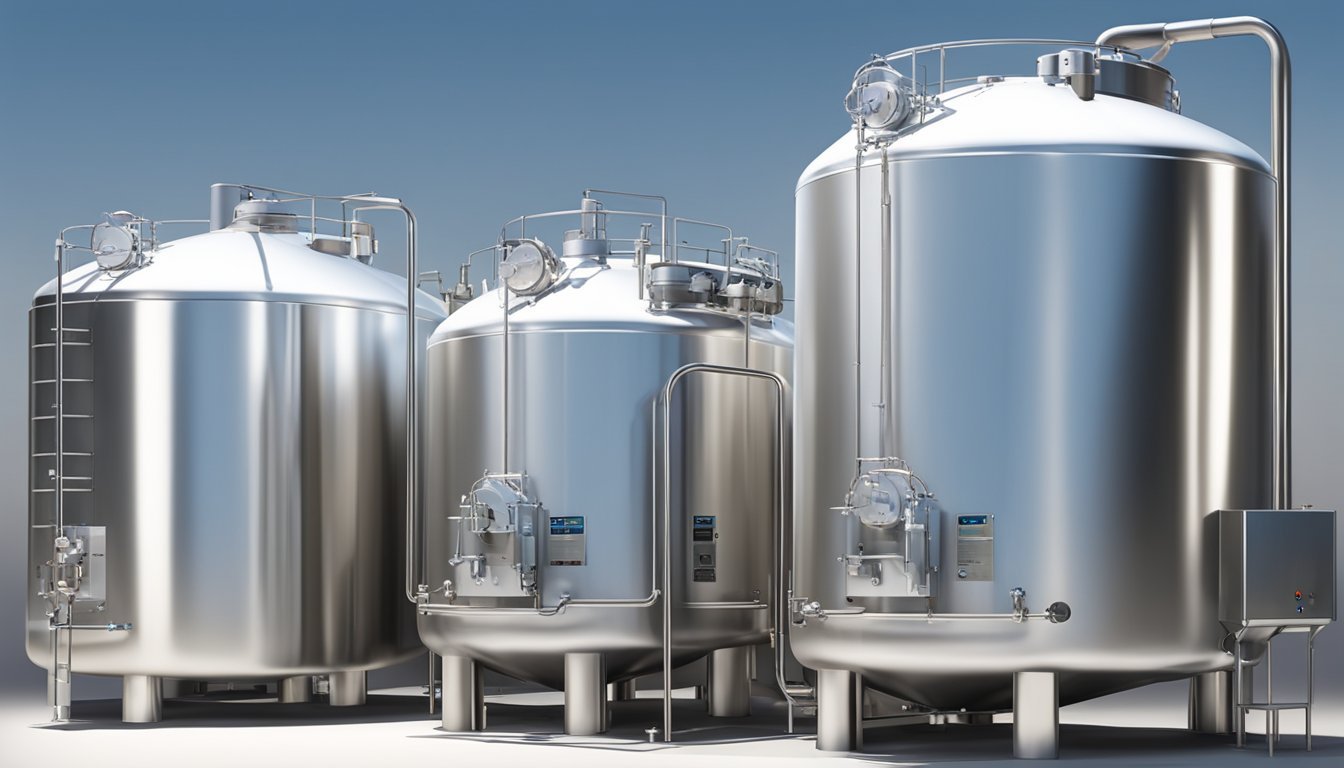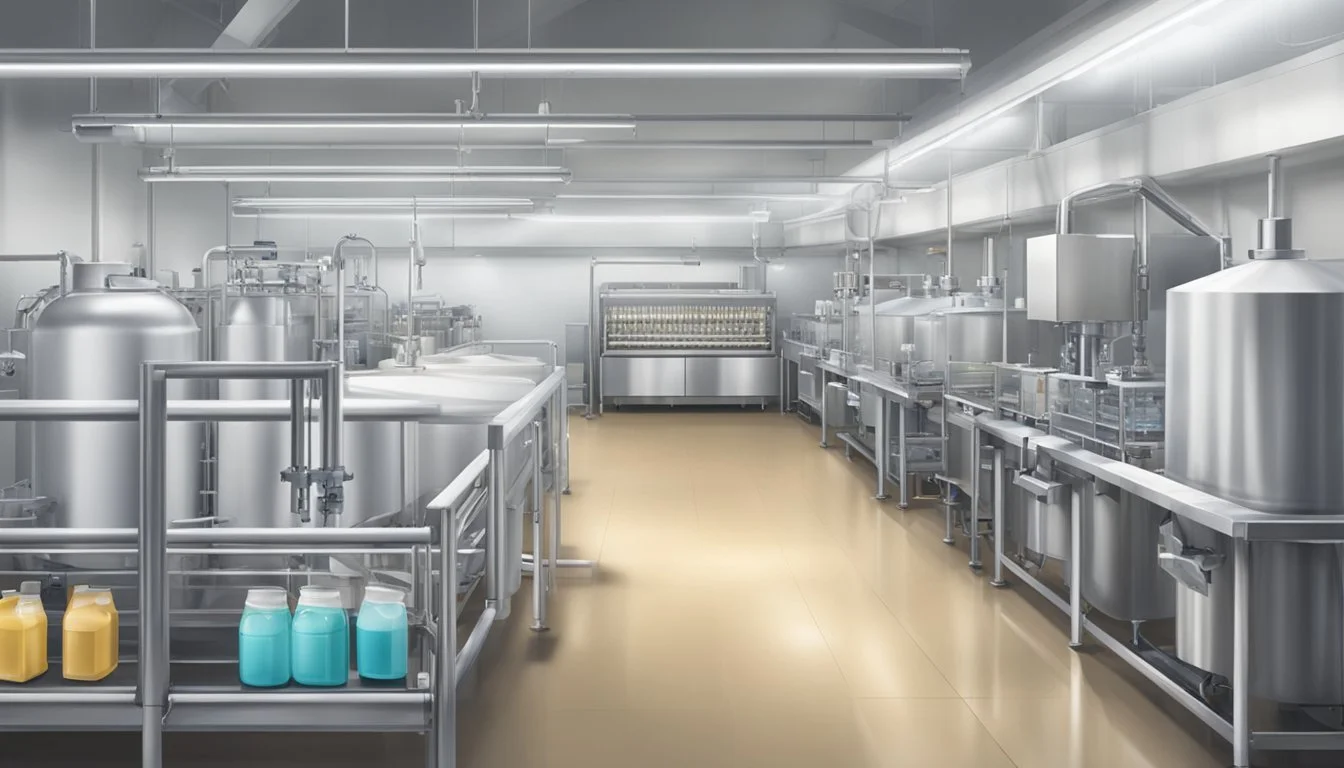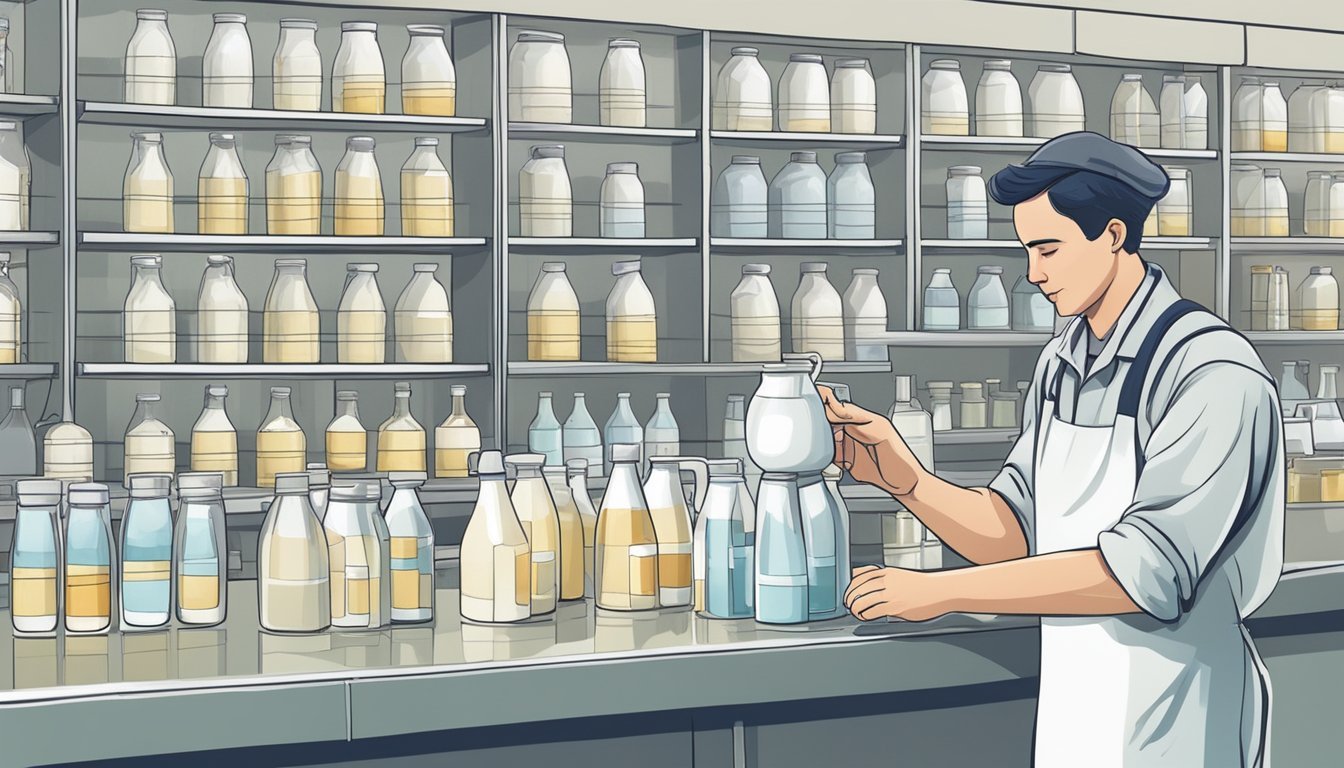How do I Ensure Milk Quality and Safety?
Key Steps for Consumers and Producers
Ensuring milk quality and safety is crucial for maintaining public health and consumer trust in dairy products. Milk needs to meet certain standards to be considered safe for consumption, which include being free from contaminants and pathogens. Several factors influence the quality of milk, such as the health and diet of the cows, the conditions under which the milk is collected, and the methods used in processing and storage.
At every stage from farm to table, strict practices must be employed to guarantee the highest possible global food safety and quality standards. This includes testing for bacterial counts, avoiding the presence of antibiotics and other harmful chemicals, and ensuring that the milk is kept at the correct temperature to prevent spoilage or the growth of harmful microbes. Details on how to collect milk samples correctly are also critical for assessing milk quality in a laboratory setting.
Producers and processors must adhere to regulations and guidelines designed to maintain the integrity of milk. The use of proper sanitation practices, regular inspection, and quality testing methods are key components in ensuring that milk and its derived products are not only of high quality but also safe for the consumer. This collaborative effort across the dairy industry helps to uphold the standards that consumers expect and rely on for their daily nutrition.
Understanding Milk Quality
Ensuring milk quality is paramount for consumer health and industry standards. It encompasses various parameters including somatic cell counts, nutritional content, and absence of contaminants.
Defining Quality Parameters
Quality parameters of milk include protein and fat content, as well as the absence of contaminants like antibiotics or pathogens. It's essential that milk is free of off-flavors, abnormal colors, or odors. These indicators help determine if the milk is suitable for consumption and further processing.
Significance of Somatic Cell Counts
The somatic cell count (SCC) is a critical indicator of milk quality, reflecting the health of the dairy animals. A lower SCC is often an indicator of good animal health and milk quality. Conversely, a higher SCC may suggest mastitis, an infection of the mammary gland, which can lead to poorer milk quality.
Milk Nutritional Aspects
Nutritionally, milk is valued for its contents of protein, fat, vitamins, and minerals. Adequate levels of these nutrients signify high-quality milk. It's also evaluated for its bacterial count, which needs to be minimal to ensure both its safety and nutritional quality.
Knowledge about the intricacies of milk quality helps consumers understand the value and safety of dairy products they consume.
Dairy Farming Essentials
To ensure milk quality and safety, dairy farming essentials focus on maintaining the health and welfare of cattle, managing feed and nutrition effectively, and optimizing the housing and environmental conditions.
Cattle Health and Welfare
Cattle health is paramount in dairy farming, as healthy cows are the cornerstone of high-quality milk production. Dairy farmers must implement regular veterinary check-ups and develop health management programs to prevent diseases like mastitis, a common infection of the mammary gland. They should also minimize animal stress, which can compromise the immune system, lead to health issues, and affect milk production.
Feed and Nutrition Management
Proper feed management plays a critical role in the quality of milk. Cows require a balanced diet to ensure they produce milk that is safe and of high quality. Dairy farmers should provide a range of nutrients, including carbohydrates, proteins, fats, minerals, and vitamins, to meet the specific needs of their herd. This approach supports the overall health and productivity of the cattle.
Housing and Environmental Factors
The design and maintenance of dairy housing can significantly impact milk safety and quality. Factors such as bedding, ventilation, and the cleanliness of stalls affect the cows' well-being. Suitable bedding materials help to prevent injuries and reduce bacterial growth, while proper ventilation systems ensure fresh air and a comfortable environment, both crucial for maintaining the health of dairy cows and the quality of milk they produce.
Milking Procedures and Equipment
To ensure milk quality and safety, it is essential to adhere to stringent milking procedures and maintain impeccable cleanliness of the equipment. The following practices are critical in safeguarding the integrity of milk throughout the collection process.
Hygienic Milking Protocols
Milk quality begins with the health and cleanliness of the cows themselves. Udder preparation is imperative; cows should have their udders cleaned and dried before milking to reduce the risk of contamination. Consistent milking hygiene protocols, such as pre-milking teat disinfection, help prevent mastitis and ensure the better quality of the milk collected. The University of Florida's IFAS Extension supports the importance of milking clean, dry, and well-stimulated teats to optimize milking efficiency.
Equipment Cleaning and Sterilization
Milking equipment must be thoroughly sanitized before and after each use to prevent the introduction of pathogens into the milk supply. This includes sterilizing teat cups, milk lines, and storage containers. Penn State Extension highlights the importance of a well-maintained milking system, suggesting rigorous cleaning protocols are essential to safeguard against contamination, ultimately affecting milk safety and quality.
Milking Technique and Regularity
Proper milking technique and consistent routine are vital to ensure the safety of milk. Cows should be milked at regular intervals to maintain udder health and milk production consistency. The application of milking machines should occur within a minute after teat stimulation to optimize milk let-down, and the units should be removed promptly to prevent over-milking. Resources like the University of New Hampshire Extension recommend specific timeframes for machine application and milk-out to promote both animal welfare and milk yield efficiency.
Milk Handling and Storage
Ensuring milk quality and safety throughout its journey from the farm to the consumer relies heavily on proper handling and storage practices. Adherence to strict temperature controls and hygienic handling processes are critical to prevent spoilage and extend shelf life.
From Cow to Container
The initial step in safeguarding milk quality is proper milking hygiene. It is essential that dairy farmers employ clean and sanitized equipment, along with ensuring the good health of the cows. The collected milk should be rapidly cooled and transferred to clean and sanitized containers which helps in reducing the risks of bacterial growth and spoilage.
Milk hygiene and milk preservation are interlinked. The process involves thorough cleaning of the udders before milking, using sterile containers, and immediate cooling of the milk after collection to maintain its freshness and safety.
Temperature Control and Spoilage Prevention
Refrigeration is pivotal in controlling milk temperature and preventing spoilage. Grade A milk, by law, must be stored at 45 °F or below, which hampers bacterial growth. However, maintaining temperatures well below 40 °F is crucial for preserving the milk's quality. These temperatures need to be consistent through every phase including warehousing, distribution, and delivery to ensure safety and prevent spoilage.
In the case of milk products, safe handling of milk and dairy products is key to longevity, ensuring that products remain good for consumption and maintain their nutritional value. Continuous cold chain management is crucial from the point of collection through to delivery to the consumer's home.
Storage Facilities and Duration
The design of milk storage facilities should facilitate consistent refrigeration. In refrigerated conditions, milk quality can be maintained for a significant duration before consumption. The refrigeration units must be reliable and capable of maintaining the necessary temperatures.
Regarding the shelf life of milk, specific durations must be adhered to, depending on the method of storage. Breast milk storage guidelines, for example, differ based on whether it's kept at room temperature, refrigerated, or frozen, applying to cow milk similarly in principle. For long-term storage, deep freezing is recommended as it can keep milk safe for up to 12 months, but once thawed, refreezing is strongly discouraged as it can degrade milk’s quality and nutritional content.
Quality Control and Safety Measures
Ensuring the safety and quality of milk is a multidisciplinary process involving meticulous testing for harmful substances, adherence to stringent regulations, and the implementation of Hazard Analysis and Critical Control Points (HACCP) principles.
Testing for Contaminants and Pathogens
Milk quality control teams conduct rigorous tests to detect microorganisms, pathogens, and contaminants that can pose serious health risks. They screen for bacteria such as Listeria monocytogenes and Salmonella, which are known to cause foodborne illnesses. Tuberculosis bacteria testing is also crucial, as infected milk can be a public health concern. Additionally, laboratories test for a list of mycotoxins—toxic compounds produced by certain fungi. It is essential to control bacterial growth and monitor milk for antibiotic residues to prevent antibiotic resistance.
Regulation and Compliance
The dairy industry must comply with local and international regulation to ensure food safety. Regulatory agencies establish standards and guidelines to minimize risk management concerns. These regulations oversee various aspects, such as the allowable levels of antibiotic residues and the presence of microorganisms. Compliance with these standards is not only a legal requirement but also a commitment to public health.
HACCP Principles in the Dairy Industry
HACCP principles serve as a systematic preventive approach to ensure food safety from biological, chemical, and physical hazards. The dairy industry develops and implements HACCP plans to identify and control critical points where hazards could affect milk safety. This includes measures to prevent the introduction of Salmonella, control microorganisms during processing, and manage bacterial growth in storage. HACCP is central to proactively managing food safety and protecting against health risks.
Milk Processing and Pasteurization
Ensuring milk quality and safety is a multi-step process, involving careful treatment of raw milk, specific pathogen elimination methods, and rigorous quality assurance practices post-pasteurization.
Raw Milk Treatment
Raw milk straight from the source contains various microorganisms that can be harmful if not properly handled. To ensure safety, milk processing plants implement several preliminary steps to treat raw milk before pasteurization. These include filtration to remove debris, clarification to separate impurities, and chilling to slow microbial growth. Depending on the specific EU standard or other regional regulations, milk quality standards at this stage are strict to prevent any preliminary contamination.
Pathogen Elimination Methods
Pasteurization is the most commonly employed method to eliminate pathogens in milk. It involves heating every particle of milk to a precise temperature for a set period. The aim is to reduce the number of viable harmful bacteria without allowing recontamination during the process. There are different pasteurization techniques, such as HTST (High-Temperature Short Time) which heats milk to 161°F for at least 15 seconds, and UHT (Ultra-High Temperature) which heats milk above 275°F for a few seconds. These methods have varying impacts on the milk, but all aim to ensure safety for human consumption while retaining the milk's nutritional value.
Quality Assurance Post-Pasteurization
After pasteurization, milk undergoes rigorous quality checks to ensure all the previous steps have been effective in maintaining a high standard of safety and quality. This includes testing for residual microorganisms and ensuring the milk remains free from contamination. Laboratories within milk processing plants conduct these tests to certify that the milk meets or exceeds all requisite safety standards before it is packaged and distributed. Regular reviews of these procedures are essential to maintain adherence to high standards.
Regulatory Framework and Standards
Ensuring milk quality and safety is underpinned by a robust regulatory framework and adherence to international standards. These regulations safeguard public health by setting minimum quality criteria for dairy products.
Understanding EU and International Guidelines
In the European Union, standards for milk and dairy products are strictly regulated to exceed high safety and quality. The EU regulatory framework includes directives that cover the entire agri-food sector, from farm to consumer. This comprehensive approach ensures that milk free of antibiotics, contaminants, and other harmful substances reaches the market, thereby protecting public health.
Regulations, such as those from the European Food Safety Authority (EFSA), are in place to set maximum residue limits for veterinary medicines in foods. Dairy farms are required to follow these guidelines to guarantee the quality and safety of their milk. Internationally, organizations like the Food and Agriculture Organization (FAO) provide guidance on milk quality and testing. This includes parameters such as:
Absence of debris and sediment
Free from off-flavours and abnormal colour or odour
Low bacterial count
No chemical contaminants (e.g., antibiotics, detergents)
Normal composition and acidity
These quality indicators are crucial as they directly affect the safety and consumer acceptance of milk and milk products.
Dairy Industry Certifications
Within the dairy industry, various certifications exist that attest to compliance with food safety and quality standards. These certifications often go beyond legal requirements to ensure excellence in dairy production.
One such example is the Dairy Industry's voluntary adoption of HACCP (Hazard Analysis Critical Control Point) principles. HACCP is a management system that addresses food safety through the analysis and control of biological, chemical, and physical hazards from production, procurement, and handling, to manufacturing, distribution, and consumption of the finished product.
Another layer of quality assurance comes from third-party certifications by organizations such as ISO (International Organization for Standardization). ISO standards, like ISO 22000 for Food Safety Management, demonstrate a dairy processor's commitment to maintaining a high level of food safety and continuous improvement in their processes.
By adhering to these rigorous guidelines and gaining certifications, the dairy industry ensures that the milk consumers receive is not only compliant with regulations but also of superior quality.
Consumer Safety and Public Health
Ensuring the quality and safety of milk is crucial for maintaining public health. Milk can be a nutritious part of the diet but can also be a vector for foodborne illnesses if not properly handled and processed.
Impact of Milk on Human Health
Milk is a significant source of nutrients including calcium, vitamin D, and protein, which are essential for human health. However, the consumption of contaminated milk can lead to serious health issues. Brucellosis and E. coli infections are examples of diseases that can be transmitted through milk, potentially causing fever, gastrointestinal distress, and more severe complications, particularly in vulnerable populations.
Preventing Foodborne Illnesses
To prevent foodborne illnesses related to milk consumption, strict adherence to food safety practices is imperative. This includes the implementation of hygienic control throughout the milk production process. Measures, such as pasteurization, effectively reduce the risk of contamination, thereby securing milk as a safe food product. Preventing the transmission of pathogens like E. coli in milk also involves regular testing for contaminants and following the guidelines established by food safety authorities. Educating consumers about the risks of consuming raw milk, which may contain harmful bacteria that can cause allergies, fever, and other foodborne illnesses, is an essential component of public health strategies.
Best Practices for Dairy Producers
Ensuring high-quality milk production involves careful attention to animal well-being, stringent cleanliness protocols, and active participation in community and market initiatives.
Maintaining Animal Health
Optimal dairy animal health is fundamental for quality milk production. Regular veterinary check-ups and vaccinations keep dairy species healthy and productive. Implementing feed management practices that meet nutritional needs and monitoring for signs of illness are crucial steps. A dairy farm adopting these best practices can prevent the spread of disease among the herd.
Sanitation and Hygiene Education
Establishing rigorous sanitation and hygiene protocols is key to maintaining hygienic conditions. This encompasses systematic cleaning and disinfection of all equipment used in milking, as well as the facilities where dairy animals reside. Educating farm workers on the importance of cleanliness can aid in achieving consistently high levels of milk safety and hygiene.
Community and Market Engagement
Active engagement with the dairy community and market stakeholders involves advocating for practices that enhance milk safety. Sharing knowledge about milk culturing and the importance of safe milk handling practices fosters a culture of quality throughout the industry. This collaborative approach is especially vital with the trend toward dairy intensification, where maintaining high standards of milk quality becomes increasingly challenging.
Future Trends and Innovations
The continuous evolution in the milk industry is fundamentally linked to technology and sustainability. Practitioners are increasingly adopting next-generation practices to enhance milk quality and ensure safety.
Dairy Sector Sustainability
The dairy sector is actively moving towards sustainable practices including the use of virtual fences that minimize environmental impact. Robotic systems promise greater efficiency and a reduced carbon footprint. Environmental management systems are also being implemented to systematically track and improve the ecological balance within the dairy industry.
Technological Advances in Milk Analysis
Advanced milk testing techniques are critical for maintaining high milk quality. Innovations such as intuitive infrared technologies and rapid ELISA kits have enabled more sophisticated, real-time testing of milk. This allows for immediate best practices in addressing quality concerns, ensuring consumer safety remains paramount. Dairy processors now have access to detailed analytics for improved decision-making.







